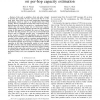Free Online Productivity Tools
i2Speak
i2Symbol
i2OCR
iTex2Img
iWeb2Print
iWeb2Shot
i2Type
iPdf2Split
iPdf2Merge
i2Bopomofo
i2Arabic
i2Style
i2Image
i2PDF
iLatex2Rtf
Sci2ools
INFOCOM
2003
IEEE
2003
IEEE
The effect of layer-2 store-and-forward devices on per-hop capacity estimation
— Tools such as pathchar, clink, and pchar attempt to measure the capacity of every Layer-3 (L3) hop in a network path. These tools use the same underlying measurement methodology, which we refer to as Variable Packet Size (VPS) probing. The key assumption in VPS is that each L3 hop along a path increases the delay of a packet by a “serialization latency”, which is the ratio of the packet size over that hop’s capacity. Unfortunately, the capacity estimates of VPS tools are sometimes wrong. In this paper, we investigate the source of these errors, and show that the presence of Layer-2 (L2) store-and-forward devices, such as Ethernet switches, have a detrimental effect on the accuracy of VPS tools. Specifically, each L2 store-andforward device introduces an additional serialization latency in a packet’s delay, which results in consistent underestimation of that L3 hop’s capacity. We analyze this negative effect, deriving the measured capacity of an L3 hop as a function of th...
Communications | Hop’s Capacity | INFOCOM 2003 | L3 Hop | VPS Tools |
| Added | 04 Jul 2010 |
| Updated | 04 Jul 2010 |
| Type | Conference |
| Year | 2003 |
| Where | INFOCOM |
| Authors | Ravi Prasad, Constantinos Dovrolis, Bruce A. Mah |
Comments (0)

